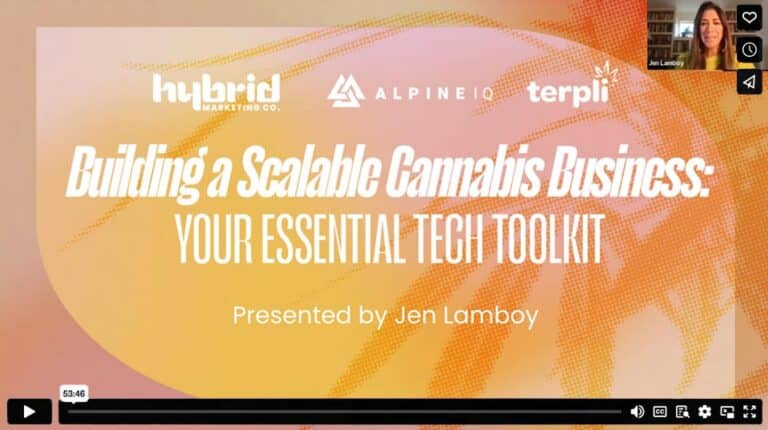Host: Jen Lamboy, Director of Strategy, Hybrid Marketing Co.
Guests: Eric Mercado, CPA, Terpli Founder &
West Paschal, Chief Revenue Officer at Alpine IQ
Jen Lamboy, Director of Strategy, Hybrid Marketing Co.
All right, guys. Thank you so much for joining us for our chat on Building a Scalable Cannabis Business: Your Essential Tech Toolkit. I’m Jen Lamboy, I’m the Director of Strategy here at Hybrid Marketing Co We are a business outcomes focused cannabis agency. We have been at it since 2015, specifically in cannabis. We even have some folks on our team who have been in the space since 2011.
We focus primarily on driving revenue, reducing risk, reducing cost, and that’s why I’ve invited these two gents here to have this conversation on tech, some of the best in the cannabis space. I’m joined by Eric Mercado of Terpli and West Paschal of Alpine IQ. So we’re going to just jump right into the conversation. I’m going to let these two guys give a quick intro of who they are, what they do in the space, and yeah, go ahead, why don’t West, go ahead and jump in first.
West Paschal, Chief Revenue Officer at Alpine IQ
Yeah, absolutely. Well, West here. I came into the cannabis space in 2018 because I was passionate about the plant like so many other people and wanted to make a career out of being in this space. I started off doing business development and M&A for Tilray, which back then was expanding as quickly as they could through Canada and specifically I looked mainly at the retail sector working with a bunch of people that were early licensees after Canada federally legalized. And it was through that experience that we realized there was a large data and marketing gap that needed to be fixed with technology.
And fortunately for me, my brother, Alpine IQ’s CEO, was ready to develop a software that we’ve now grown over the last three years to serve over 3,000 dispensary doors and we work with a number of brands as well, powering marketing, data analytics, loyalty programs, kind of a full suite of tools.
Jen Lamboy, Director of Strategy, Hybrid Marketing Co.
So Eric, jump in there.
Eric Mercado, CPA, Terpli Founder
Hi everybody. Thanks for joining us today. My name is Eric Mercado. I’m one of the founders of Terpli. It’s an AI budtender.
My previous life I was actually a Big 4 auditor for about 10 years. Did the full gambit, started off in Dallas, TX, actually right where West is from as well. Oil and Gas Real Estate, did a couple of restaurant group IPO’s, did a lead recycling and smelting company, which is exactly as glamorous as you imagine. But Biggest home run of my career was actually an ecommerce growth leader called Solo Stove.
If you guys haven’t heard of them, they do the smokeless stainless steel fire pits. They own an origami kayak company and inflatable paddle board company. They own Chubby’s, the short shorts. I was actually the lead on the EY side that rolled that up to go public in October of 21.
Their ticker’s DTC. That’s right when my best friend and roommate – we have the same birthday, whole 9 yards from college – Peter, approached me with the ideology of Terpli, which was intended originally to be a recommendation engine focused on COA content, Turpine and cannabinoid content of cannabis products and user reviews in order to focus on outcomes for individuals. Rather than indica, sativa, hybrid, rather than strain name, and rather than THC and pricing, to focus on how this can actually help people. I was in the midst of my own woes with working conditions in my previous experience, and I found that the way that I was reacting to cannabis products was changing.
I didn’t know why my biochemistry was changing, the phenotypes of products were changing. How could I get the outcomes I desired with the products that were available for me? What we found was that the ecommerce experience was lacking many times. Honestly, it kind of sucked. It’s a glorified inventory with a listing with a bunch of made-up names.
How can we drive meaningful outcomes for end consumers? That’s where we created Terpli, partnered with folks like Alpine IQ and other ecommerce players in the space to give that differentiated experience.
Jen Lamboy, Director of Strategy, Hybrid Marketing Co.
Awesome. So if you’ll notice, you know those who are with us, you know as part of the conversation too when we’re talking about some of these software solutions, it’s part of a much larger sales and marketing tech stack. So one of the most important pieces when you’re building, whether you’re on the retail side, the B2B side, let’s say you’re a brand, even an ancillary organization is when you’re starting to pick or look through or even optimize the software solutions you’re using right now, you want to make sure that they speak nicely to each other and integrate. So I’m hoping you guys can talk a little bit about that like, what is the value of really having almost like that enterprise level or super sophisticated software solution when we’re trying to paint the most accurate picture of data?
West Paschal, Chief Revenue Officer at Alpine IQ
Yeah. No, I can take that one. I mean, integrations are kind of the core thing that power all of the other tools that Alpine IQ offers to retailers. So in order for us to be able to build incredible marketing programs, in order to be able to really understand what customers are buying, who is buying what and why, what customers are, you know attending your stores and then are no longer going back there to shop, and what’s driving those decisions? All of that comes from having data, not just from maybe a point of sale connection, but also on your website as well. Understanding what, where people are spending time on your website. Are they reading blogs or watching videos? And connecting that all back into the purchasing behavior, I mean all of that is driven through having amazing integrations with a number of partners out there.
And so you know, if I’m speaking to a retailer, I would say you know, make sure that the people that you’re working with are ready, willing and able to integrate with the vendors that you need to be successful. Because at the end of the day, if we are all here to serve you and the end consumer, our goal should just be to build the best tools we can. And work together as best we can.
Eric Mercado, CPA, Terpli Founder
Yeah, and I think a portion of that too, just to expand on what West said, we have to look at the history of the industry at large. It’s fairly nascent. It’s a smaller industry compared to many of the, you know, massive industries that are out there. We don’t have ADP. We don’t have many of the major ERP systems that have created holistic solutions that are able to combine many different components of the way that a business operates. Instead, what has been created, because of the lack of willingness for those outside and large conglomerates to participate in cannabis, is a very siloed approach that solves an individual solution one at a time, that the revolution of that technology is starting to be able to provide one stop shop solutions. But there’s also different strokes for different folks.
Everybody wants to have their own solution. Everybody has a market that’s slightly different, so it is difficult to have a one stop shop. So with that being the environment of technology and cannabis, it’s even more important to be friends with everybody, to have an opportunity to collaborate and integrate. That’s the only way that we’re going to truly doctor innovation in the space, especially from the technological side.
Jen Lamboy, Director of Strategy, Hybrid Marketing Co.
Sure, absolutely. I’ll also show this little CHEAT SHEET that shows all of those different variations that Eric’s kind of talking about. One organization’s marketing sales tech stack isn’t going to look exactly like another’s, even within the dispensary space. As a cannabis marketing agency, we have recommendations. We know what works well together. But markets are different. Laws are different. Consumer behavior I would say might be kind of consistent across the board, but then you’ve got all these really different target audience segments as well. One thing I do want to touch on too is, OK, let’s say you have figured out how to build your tech stack. You know the tools that are going to work well together. How good are your tools if you don’t have a dedicated team member who understands how to use them?
West Paschal, Chief Revenue Officer at Alpine IQ
Yeah, I can. I can jump on this one first. Totally. I, you know, we’ve gone out and sold our software now to, you know, over 1000 operators, 3000 doors and every single one of those are varying sizes. You know, I would say a ton of dispensary operators out there are operating with less than five employees sometimes.
And you know, I always encourage people to look within. You know, there might be somebody who came into this space because they’re super young and passionate and they may have an interest in taking up the mantle on running some of the tools that you’re using. And some of those people that I’ve worked with have been incredible and have made magic out of our solutions and come up with incredibly creative programs. And I would say when there’s a gap and you don’t have that expertise, or there’s a competency gap, we work with a ton of marketing agencies that have people who have sat in retailer shoes and used our platform.
And you know, we have a list of those people as dedicated partners who have, you know, done even certifications through our training programs to then be able to say, hey, we can step in and help you from a creative perspective, from a strategy perspective. And then the last thing I’ll say is as as a software provider, we’re constantly looking to provide tools to retailers that have minimal time for deployment. So we’ve come up with things like recipe deployments, where people can do quick setups of really complicated campaigns like refer-a-friend programs with just a click of a button within our system, and there’s a number of campaigns that are somewhat set it and forget it. So there’s a lot that you can do to drive revenue from an initial setup and continuing to message those customers automatically using segmentation, things like birthday campaigns are a great example. So those are kind of the three things that I would say is you might have someone passionate within. There’s a ton of amazing experts that we’ve worked with and continue to work with that can help you and we’re always trying to make it easier to use the platform with a minimal amount of actual time devoted to it.
Eric Mercado, CPA, Terpli Founder
Yeah. And to kind of expand on that from West, as well as many times with very sophisticated technology you’re limited to your knowledge base in being able to leverage it to its maximum capability. I think the certification program that Alpine has created is paramount to be able to actually arm a company in leveraging it appropriately. Because many times tools that cut that and that retailers and operators are using, it’s like bringing a bazooka to a knife fight. If I don’t know how to use it appropriately, I’m wasting my money. That’s the honest answer and looking at tools outside of the cannabis space, I’m not, I’ve never been a salesperson before, but I am the head of Founder Sales at Terpli, which is a very exciting proposition for me to learn.
I’ve seen failed Salesforce implementations at some of my major clients when I was at Big 4. Counting the implementation of that software is almost as important as the software itself. And when you have, when you cheap out on the implementation of a Salesforce software, you underutilize it and it’s a waste of money. That’s why things like HubSpot are performing so much better, because they have such a wide array of resources that their users can learn from.
That’s going to be a Big differentiator for being able to maximize the use case for this. Another really important ideology is meaningful, impactful data analytics. Many providers are using what Peter refers to as the spaghetti method, where you take a handful of the spaghetti, you throw it at the wall and you see what sticks. That is not a meaningful way to display data to an end user. Our focus is being able to take the outcomes that customers are looking for and leverage them back into meaningful value throughout the supply chain.
But that’s a very fickle ideology. It’s really difficult to actually make that happen. So I think of equal importance from a technology player’s perspective is listening to the feedback of their partners. My favorite thing to do is go in and get feedback from my retailers on what different changes they would like to see to our reporting. What insights are they looking to understand that they don’t have an answer to from other providers?
I’ve considered myself to be a business advisor for the entirety of my career. That is where our focal point is in order to actually create meaningful outcomes for a retailer. And Jen, I think that’s very similar to what you guys are doing from a marketing/consulting standpoint is how can we listen to what you actually have to say, How can we learn from the market to understand what pain points exist because everyone is so unique and everyone’s situation is so unique. So it’s important to provide learning opportunities. It’s also much more important in my opinion, to actually provide or to listen to what the operators are saying about the impacts that they need.
Jen Lamboy, Director of Strategy, Hybrid Marketing Co.
Sure, absolutely. Well, and I love both of your points, kind of where you’re talking a little bit more about, OK, let’s say you’ve got somebody dedicated inside who understands the software. Let’s say you know where you’re going. You’ve talked to folks, the tools are great. But if you lack vision or strategy, what do you need the tools for? Where are you going next? As a marketing agency, our internal team has gone through the Alpine IQ certification process. We’ve sat on calls with Eric running demos on Terpli. We have to understand how these tools work so that we can fit them into the strategy if that makes the most sense for client, just as business owners were. So when we look at this from a business outcomes perspective, I would say we’re also on the business consultancy side for sure, even though we market ourselves as marketers.
Eric Mercado, CPA, Terpli Founder
Yeah, and it’s also an opportunity for technology to solve the problem for us. West Mentioned recipes being available. There’s Terpli audiences already built into the Alpine IQ dashboard. That is the type of collaboration that creates a holistic environment to where we’re hand holding not only the end consumer, we’re hand holding the retailers themselves in being able to leverage the tool appropriately. Now I can track Terpli users automatically.
They don’t have to do anything if I want to re engage particular customers, that’s already tracked for them. That’s the type of example of innovative collaboration that can leverage both tools to the maximum capability.
Jen Lamboy, Director of Strategy, Hybrid Marketing Co.
So I kind of touched on vision a little bit when the three of us had a conversation earlier this week too, on vision. The importance of having a vision, knowing what you’re looking for, knowing what data you’re trying to extract, knowing what data is going to really give you some direction on where to go next with business strategy and the like. Can you all talk a little bit more about what that actually means in terms of software solutions pulling data? What the heck do I do with it?
Eric Mercado, CPA, Terpli Founder
Yeah. So in terms of vision from our perspective, what we’re really focused on is the consumer experience. It’s about aggregating and understanding what customers are looking for.
One of the Big differentiators that we see with our tool versus other data analysis that’s happening in the industry right now is most retailers are making decisions based off of first party purchase information. i.e. what’s sold. Many times we don’t know why it’s sold.
It could have been because it was named a certain thing, it could have been because it had a high THC percentage, it could have been because it was actually really, really dank and it was an amazing product. We don’t really know other than word of mouth feedback, maybe, what my budtenders are aggregating. But there’s really not a data-driven approach to understanding what that means. So what our focus is on zero party consumer preference information. When they go through the Terpli experience, they’re essentially filling out a questionnaire. How do you want to feel? How do you want to consume? What potency do you want, What terpene content do you want? What price are you willing to pay for that experience? Those are all super valuable zero party consumer preference information that we can then tie back to purchase history with an Alpine IQ.
We can tie it back to review criteria for feedback and understanding of what it actually did to that end consumer. Then, and only then are we able to actually understand what customers are asking for, how to appropriately cultivate, process, have appropriate inventory, mix, market and sell those products better, and then leverage partnerships with the likes of an Alpine IQ to pointedly reach out to that consumer. The way that ecommerce works everywhere else, except for cannabis, is that you have a personalized and holistic experience. Right now Cannabis is, as I mentioned, kind of a glorified inventory listing with a bunch of made-up names.
It’s really, really hard for customers to differentiate between products. If you can’t differentiate between products, what happens from a consumer psyche perspective is that you commoditize. If products are commoditized in your mind, that means that they are all the same. And if I can’t differentiate between those products, the only levers that we’ve really armed end consumers with right now is to shop based off of indica, sativa, hybrid designation or strain name – which is unfortunately known to be fabricated across the supply chain – THC percentage – which that’s a whole different rabbit hole – and price. And if I don’t trust indica, sativa, hybrid and strain name designation, really the only thing we’re arming our consumers with is price and THC, which are really the two things that I think most people in the industry would agree we want to get away from. Forces us deeper into price compression. It forces us deeper into lab shopping and all of these other inherent issues. So if we’re able to battle through that, focus on transparency for the end consumer and a holistic loyal experience for them to be reengaged, and create a way of buying, now we really have a legitimate ecommerce and retail experience that has the longevity that we need.
West Paschal, Chief Revenue Officer at Alpine IQ
Yeah, I mean you nailed it, Eric. I think that there’s a limited amount of information that customers have available to them to make informed decisions and then there’s also a limited amount of time or ways that you can actually communicate that information. So data is the foundation for being able to take that 7 to 11 minute conversation that you have between a budtender and a customer in store and to use that data to then allow brands and retailers to have a voice to speak to that customer to ask them for feedback or direction via surveys. And then to use all of that to inform the next, you know, opportunity to serve that customer. And I always say, you know, using data to inform the business is why we built Alpine IQ. If I can keep one negative cannabis experience from happening by using data to guide a customer to a better purchasing decision, then I feel like our software is doing a good job. You know, I always like to reference my own mom who, you know, didn’t consume cannabis for 20 years. And if she goes into a store, she doesn’t need to be sold a 35% THC infused joint. Like, my mom needs something with, you know, 1 to 1 CBD or even, you know, stronger CBD ratio, 2 to 1, and something that’s very, very minimal compared to somebody else who’s a regular consumer coming in.
And with data, there’s ways that budtenders can have that information at their fingertips and they can actually use that to then create a much better, more home experience for the customer when they shop. So they feel like the retailer that they’re going to actually understands them. And so that’s, I think data is the only thing that allows for us to be able to get to that point. And you know, there’s so much out there I think, in so many markets, almost every ID is being scanned.
And you know, we make a pledge never to sell that data, never to monetize that data, but rather just to create tools that are going to help customers have better experiences with it.
Eric Mercado, CPA, Terpli Founder
Yeah. And I think a lot of that too is nuance. Each individual has a different endocannabinoid system. Each product is slightly different. So for us to give blanket recommendations for unique experiences, I think is under servicing the entire industry.
And it’s part of the problem with legitimization, if people can’t trust the products that they have. Health and safety standards are paramount. Absolutely. But it also that this is a psychosomatic product. It is heavily influenced by the experience that you have through the buying process. It’s heavily influenced on the experience that you have in the consumption process and then the experience after consumption. All of those roll into what my overarching thought is on the cannabis space and cannabis products in general. To West’s point, winning at that first experience is paramount for trust in especially the canna curious, especially in nascent markets. If my grandmother, like West’s mom, if my grandmother came in and she bought Cheetah Piss, I would keel over and die, right? That is a naming convention that she ain’t going to buy.
More importantly, if it was labeled as an indica and she was told by a budtender that it would make her go to sleep, and she’s got anything like the biochemistry that I have where THC is a natural stimulant and I need something higher in [indecipherable] to be able to actually relax because I’m crazy person and hyperactive. That if she then had the experience where she’s awake until 2:00 in the morning with her mind racing because she’s super high, because it was too strong and not the format that she needed, we’ve lost that customer. More than likely we’ve broken the trust in the retail provider that provided the product. That brand might be dead to her. More than likely in a nascent market the entire industry is dead for that individual. We’ve lost that canna curious customer. It’s different than it was back in the 60s and 70s for the older customers for sure. And products are constantly changing, getting crazier naming conventions. How can we service them in a way that they’re used to, that they’ll trust going forward?
Jen Lamboy, Director of Strategy, Hybrid Marketing Co.
Sure, and in a consistent way too.
Eric Mercado, CPA, Terpli Founder
Exactly. Quality control is a whole other rabbit hole.
Jen Lamboy, Director of Strategy, Hybrid Marketing Co.
I’m gonna, I’m gonna jump into a question. So Sandra Bergman is on, she’s an attendee, but she also knows Alpine IQ really well. She’s a consultant with an organization called Sage. If you don’t know her, also kind of connect with her on LinkedIn too. She’s become a great resource for our organization as well as within the space. Her comment is, she totally agrees with you guys about needing to move consumers beyond the price and THC potency conversation. But when she talks to people outside of the industry that seems a long way off. How can we accelerate that process for people that aren’t going into dispensaries and talking to a retailer?
West Paschal, Chief Revenue Officer at Alpine IQ
Hey, Sandra, I didn’t realize you were in the room, excited that you’re here. So I would say that one of the things that I think will play a huge role in accelerating that is the change of native apps in the space. When we started Alpine IQ three years ago, native apps were not allowed by Apple whatsoever. And you know, as texting infiltration became more difficult, all of a sudden Apple changed their policies. And I think that when we talk about that limited amount of time, you know, I say 7 to 11 minutes if you’re an express store, it might even be 2 to 11 minutes if you’re just an in-and-out small footprint shop.
And so having the ability to educate customers outside of those four walls is so important. Native apps, custom native apps can have pages that are entirely devoted to educational content. We have a number of retailers who have their own educational portals within our apps, and that gives the customer the ability to dive in and learn more and grow to understand the things that they’re purchasing a lot more. And you know that that might include information about terpenes. It might include information about minor cannabinoids. It might, you know, include information about how THC and CBD degrade and turn into other cannabinoids like CBN as they get oxidized. So there’s so many opportunities for us to speak to customers in a way that goes way deeper than we have the opportunity to in our stores. And I think the opening up of native apps opens that door for how we put that information in the palm of our customers hands.
Jen Lamboy, Director of Strategy, Hybrid Marketing Co.
Sure, absolutely. And I think it’s, I think what’s most important about that is that we understand that folks are shopping online many more times before they’re actually entering a dispensary door. So we work with folks, of course, in mature markets, emerging markets, dispensaries kind of throughout that whole chain, we’re finding that on the emerging market side that we’ve got to make a bigger splash before doors open because we know now, especially post-Covid, we’re so trained to shop online, we’re looking, you know, if we look at the segments of the target audience that are purchasing most, we know that they’re. We know they’re looking online. So what’s wonderful about, you know, having that at your fingertips is you can dig as much as you want versus when you walk in-store, maybe you can have a 20 minute conversation with a budtender, maybe you can’t.
Eric Mercado, CPA, Terpli Founder
Yeah, and I think from an end consumer standpoint, there’s really two schools of thought in my opinion. Here you have it. From the retail dollars & cents perspective, pushing more users to shop online is better for overhead. Do you sometimes sacrifice a lack of soft touch for the budtender experience? Yes, many times. Truthfully, people don’t actually enjoy the budtender experience. No matter how hard we try. They don’t like it, especially the younger demographic in Colorado. Many times, I’m sure you guys have been to a lot of the dispensaries here, it feels like you’re in a jail cell until you’re ready to be seen, which doesn’t feel very good, right? That is an entirely different experience that we’re looking to revamp and modify when it comes to the e-commerce experience. Pushing more customers to shop online is cheaper for you on the margin as a retailer. That’s a truth.
So the migration from box store shopping to online shopping has happened in every other retail market. We need to accept that that’s more than likely going to happen. So rather than combating it, we need to lean in and understand how we can then translate all of the work that we’ve done to differentiate ourselves in the store into the online landscape. And to West’s point, I think a huge part of that is messaging. I think a huge part of that is education. I think a huge part of that as well is product differentiation and allowing a customer to have more levers to pull.
But it has to be a dynamic environment. Nobody wants to be called, no one wants to feel stupid for not knowing what a terpene and minor cannabinoid is. Nobody. But if I asked five different people to pronounce beta caryophyllene, I think I’d get 5 different answers. I don’t even know if I’m saying it correctly. And it’s kind of my job. And so that’s really, really intimidating for an end consumer, especially in a nascent market.
So you have to provide optionality. You can provide them an experience that they’re handheld and that someone tells them what to do. That’s what Amazon does. You don’t go on Amazon and filter through 11,000 products. It says, hey Jen, we did the research and this is what you want. Trust us, right? And more than likely you’re going to buy one of those top five products that’s put right in front of your face as soon as you do get a chance to maybe dive into some reviews or dive into the description of that product.
For others, they want to do much, much more research. That’s where they can dive into the education pages on the mobile app, where they can dive into our screens within Terpli, where they can see the terpene and cannabinoid content of a product and learn about what other organic compounds it’s found in. Most importantly, why should they care? That is an opportunity to educate a consumer without forcing it down their throat, because if you make them feel stupid, they’re not going to trust this process either. So it’s really about providing a dynamic environment with all of these tools available.
Jen Lamboy, Director of Strategy, Hybrid Marketing Co.
I wonder, well, I’m thinking of forcing things down people’s throats, we think about the brands who have a really limited voice, who would like to get their brands in front of more folks. How can brands actually leverage the tools that are out there now? Even some of your, you know, with Alpine IQ and Terpli as well.
West Paschal, Chief Revenue Officer at Alpine IQ
Yeah. Today Alpine IQ has a number of solutions that are geared specifically towards brand operators. A few of those include, you know, the ability to have your own direct to consumer mailing list in many places. You know, people still go to brand websites to learn more. And if you have a great website that has information that customers want, you can grow that natural traffic. You can have a list of your own that you communicate with regularly.
We also have tools geared at connecting brands with our retailers that use Alpine IQ. So there’s an entire suite of tools that are aimed at collaborative marketing. So being able to jump in design campaigns together, share in the budgeting process of deploying those campaigns and then seeing the feedback and whether or not it moved the needle for the brand themselves.
At the end of the day, the retailers have the clearest channel to be able to speak to the customer, and I think many times they want brands to help them understand better how to sell their product and better how to connect their product with the customers that they’re trying to connect with. So yeah, those co-marketing tools that we offer are super helpful for brands to be able to work with our retail network and send campaigns.
And then on top of that, there’s the ability to have out of home marketing through sponsoring of events, local charities. Anytime a brand is active in their community, they can have signup pages, they can send surveys out to their customers. All of that can feed into them kind of owning their own voice, so to speak. And so I would say that those are kind of the main tools today.
And then I would add one last one, being the ability for brands to work better with budtenders. So Alpine IQ offers a solution now geared at helping brands be able to educate budtenders on the front line more clearly and be able to communicate with them and and even push them to have goals in the way that they’re selling their products. So all of those are things that are now available that will help brands have a louder voice than they’ve ever had.
Eric Mercado, CPA, Terpli Founder
And I think there’s a, there’s from our perspective, there’s a couple of tools, and then there’s a couple of future state dreams that I have. So those are kind of two different avenues there. In the current state, we actually just launched our very first brand specific version of the Terpli tool here at Summit in Colorado, specifically focused on servicing their Jane portal that they have on their website, helping them with their popups. They do hundreds of popups across all the retail locations across Colorado. Being able to have something new to talk about, something dynamic, a way to route customers to a product that will work for them based off of the terpene and cannabinoid content in the products that they’ve worked so hard to create that will not only allow them to, you know, run Terpli on an iPad for that customer that’s going through the process, get them matched and then be able to purchase the product right there in the store, but learn about that same consumer preference criteria that customers are looking for, elicit direct reviews for their products from those consumers to get better R&D. What cut, what are customers looking for versus what do they actually say your products do.
That instance that I talked about before where I have an indica leaning product that’s marked as an indica, but 85% of my customers say that it made them feel energized. We need to change something, right? That’s really, really important. Another really exciting thing that we’re developing right now is an opportunity to sponsor products directly within our tool. It’s an interesting slippery slope because we are focused on the ethos for the way that we give recommendations.
It’s not a pay-to-play. There’s an opportunity though to have a product show up in a primary spot, but it has to be marked as a sponsored product, has to be very transparent for the end consumer that this option is here because someone paid to be here. With that being said, it is still a valid pick, so it has to fit the criteria for why we gave the recommendation. So that’s a difficult opportunity for us to be able to present, but something that we’ve been working really hard with and are beta testing right now in the Michigan market. So there’s a lot of different opportunities.
I also have to give kudos to the AIQ team because I’ve talked to a lot of retailers that have told me they had a full time person facilitating the brand versus retailer promotional calendar. It was an entire person’s job to answer the phone and say, yep, we gave that discount. Here’s how many of those discounts we gave. That is an utter, complete and utter lack of data analytics. It’s an operational nightmare.
So being able to push a promotion directly with an AIQ tool directly to that retail provider, having them have the opportunity to accept, decline that offer right there and then get data analytics after the fact. Another opportunity for collaboration from our tool, two tools is being able to push directly to a brand sponsored position on the website. So lots of cool opportunities both now and in the future.
Jen Lamboy, Director of Strategy, Hybrid Marketing Co.
I want to address a question also from one of the attendees, and West is answering it on chat. But I want everyone to hear the answer on this call. The question is “how do you ensure safety, for example, cannabis drug interactions, through your platform?” This makes me think about what will be and what is already building now on the AI side. West, jump in there.
West Paschal, Chief Revenue Officer at Alpine IQ
Yeah, absolutely. I mean as a software provider, you know, we don’t really use our platform as a means of communicating education that we would like to share with customers ever. However, our product has many applications for ensuring consumer safety. For instance, if you’ve ever discovered a product that does have something wrong with it, whether that’s, you know, vitamin E or anything that would cause harm to the customers who purchased or have purchased it, retailers can use our our system to send recall information information, and product recalls you know, are are something that people need to know about if there’s a serious health concern.
So the ability to send that not only through a text message but also an e-mail or a push notification gives maximum reach to ensure obviously that the most protection is possible. So that’s definitely one aspect. There’s also the continued ability to educate customers using our tools like the native app. So if they want to share information about CYP enzymes for instance, then they have the ability to use our tools to do so and we highly encourage that people do. I mean that’s a huge piece of this, is not only just trying to make a better customer experience, but a safer one.
Eric Mercado, CPA, Terpli Founder
Yeah, absolutely. And from our standpoint, our tool, because it is based on the underlying COA, we have direct access to the past fill ratings of those health and safety standards and we’re not going to accept a failed COA, obviously, even remediated COA’s are not our favorite. But at the same time, to West’s point, the health and safety and the trust of that end consumer is paramount for any customer in the space. And so being able to have direct access to those COA’s is incredibly important.
Jen Lamboy, Director of Strategy, Hybrid Marketing Co.
Awesome okay. I’m going to share a quick screen here, so I put together a quick little CHEAT SHEET. We’ll run through it. I just want to make sure that – we’ve talked a lot on the retail side, we’ve talked on the brand side – no matter who you are in the cannabis space, some of these are broken down into categories. But if we look at website analytics and SEO, we know that digital presence is huge, not only in this industry, especially in this industry, because we’re restricted in so many ways from using everything at our marketing fingertips, so on the website and analytics side. GA4, so if you’re familiar with Google Analytics, know that they’ve just sunsetted Universal Analytics this past summer in July. Ensure that that’s integrated onto the website, of course, Google Search Console as well. What’s nice about using those tools is there’s plenty of resources to tell you how to use them.
They’re not necessarily out-of-the-box solutions, of course. Get an education on it and that information is also readily available. We also enjoy using Semrush and Screaming Frog if you are familiar with SEO. If you want to dig into SEO, those are two tools. They’re going to give you a lot more information than you might need.
I came from the SEO world and those two, I lived by them. We also included Terpli in that list of website analytics. Also as far as, and Eric, maybe you can explain a little bit more about what you’re delivering and the experience that you offer when it comes to that.
Eric Mercado, CPA, Terpli Founder
Yeah, absolutely. So unfortunately, one of the things that they also sunset with Universal Google Analytics was Google Optimize, which was one of my favorite A/B testing tools, which is very unfortunate. So we built our own baked directly into the tool. So the way that our Terpli tool is installed is actually a GA4 script. So you’re able to install it as a separate script, a JavaScript or actually embedded in your existing GA4 script.
That’s how we’re able to do a lot of the analytics with some of our e-commerce partners like a Dutchie, like a Jane, like a Dispense and Timber to be able to track Terpli conversion rates directly within your existing GA4 dashboard, which is really great. Part of our reporting analytics is also, it’s multiple fold, but the primary reporting analytics that we’re providing number one, first and foremost is engagement levels, click through rates, dollars of influence, those great analytics. But because we are a Google Analytics script, we’re also able to provide a full conversion funnel analysis. Where are you losing your customers and your current consumer journey in your regular website? And then obviously hopefully where are you not losing those same customers within the Terpli experience?
Deltas in conversion rate and cart size are going to be part of the intrinsic ROI calculation. Other website analytics we’re able to capture are we don’t have a secondary login within Terpli. What we do is we leverage our integration with AIQ to where they log into their Alpine IQ wallet and we can use the preexisting recipes to track Terpli users directly in your AIQ dashboard. That’s how we’re able to demonstrate what the differences are in consumer behavior for a regular customer that shops online, a customer who got a Terpli recommendation, and then ultimately what happens when they come back and they become an invested customer in this process, and we have created a way of buying, how does that impact once they come back and leave a review in terms of cart size, time to return, customer lifetime value, all of those primary analytics, and how can we optimize your website to improve all of those? We are not an SEO company. Our tool is a conversion rate optimization that can just be added to your existing website in partnership with all of your existing tech stack. It’s not designed to necessarily get a bunch of new users that search “dispensary near me” onto your website. It’s designed to convert the customers that do show up. And then how can we demonstrate that impact, and how can we optimize from there?
Jen Lamboy, Director of Strategy, Hybrid Marketing Co.
Awesome. And we are an SEO company, so we can help you on the other end. Let’s see how we work together so well. All right. So for a website content management system, our go-to is WordPress. It’s the most prevalently used CMS out there. A lot of folks come to us asking about Webflow. The other part of our organization is 4B. We’re focused on technology, everything, pretty much everything outside of cannabis. So in that way we see Webflow being a pretty solid tool. It’s got a nice degree of security. The thing about that one is you can only have one user in there in the back end at a time. So in terms of building it really slows the process down. So our recommendation is WordPress if you are a business who requires some e-commerce functionality.
I’ve broken this down into two different categories of folks. Some are dispensary license holders, others are those in the hemp derived product space. So not an actual license dispensary. So on the dispensary side I added WordPress here.
The other platforms to include: WordPress + Dutchie + Terpli, WordPress + iHeart Jane + Terpli. The other is a combination of WordPress, Dispense and Terpli. So if you’re needing to of course kind of have more of that functionality with abandoned cart, any of the automations that come into place that really help move the user through a conversion process, that’s what we would recommend, any of those 3 combinations. If you are on the side of the industry where you’re selling hemp derived products, you’ll run into some limitations, so we recommend WordPress + Woo or Shopify with a combination of Jen Lamboy, Director of Strategy, Hybrid Marketing Co..
I’ll pivot over to marketing automation. I’ve divided this into a B2B & B2C just because there’s tools that work really well with some and tools that work well with others. So on the B2B side. We enjoy using and recommend Active Campaign or HubSpot if we’re talking about marketing automation.
A CRM, if you’re on a budget active campaign, has a much nicer price point coming in. HubSpot is the gold standard. That’s what we use as a marketing agency if you are on the B2C side. Again, a little bit of separation here. If you’re a license holder looking specifically for a solution for loyalty, SMS, e-mail, we certainly recommend Alpine IQ. West, give us a little bit more information around if you’re a Delta 8 product seller, why maybe Alpine IQ is an option or is not an option.
West Paschal, Chief Revenue Officer at Alpine IQ
Yeah, absolutely. So we personally as a company policy have stayed away from allowing people using our platform to market Delta 8. And you know that’s mainly around safe consumption. I mean, we’ve spent a lot of time on this call talking about how can we use our platform for consumer safety. And anytime you’re working with CBD products, you know, for the most part everyone is following general kind of FDA guidelines over what to put in those products to make sure that they’re safe.
And even though our agreements, you know, technically, obviously we’re not the sender of the message, it was still just something that we made a company policy to say, hey, unless there’s a regulated market with clean green guidelines for consumption, we don’t want to use text messaging or e-mail or push notifications to promote those products. So really just around the consumer safety aspect.
Jen Lamboy, Director of Strategy, Hybrid Marketing Co.
Awesome, awesome. Love it. The other solution there that we suggest is Klaviyo. If you are an organization who is selling Delta 8 products and Alpine IQ is not an option for you, SpringBig is another one that will help you with loyalty, SMS and e-mail.
And then on the social media side, and folks usually are already actually using Sprout Social versus a native platform, gathering insights on the native platforms don’t really provide a full enough picture. So we recommend Sprout Social. Is there anything on here that you guys would recommend that I missed or did I hit it all?
West Paschal, Chief Revenue Officer at Alpine IQ
No, I’ll say that Alpine IQ does offer B2B, you know, e-mail and marketing solutions as well. But yeah, that was the only thing that I would add. And I will say when it comes to you know Dutchie and Jane and Dispense, those have different tiers of products that you can buy and anytime you can get off of an iframe it’s going to be a better situation for SEO. And I know that Dutchie and Jane offer some degree of non-iframed products. I can’t speak to the details of both.
And then I know that Dispense, that’s kind of their Big differentiator is building for SEO. So yeah, I would just say all three have options that are SEO oriented.
Jen Lamboy, Director of Strategy, Hybrid Marketing Co.
Yeah, Dutchie Plus does kind of get you out of the iframe situation. Dispense is really exciting to watch. Jeremy Johnson, if you are on LinkedIn, follow him. He’s got a lot of information to share on SEO. He is in the marketplace. He is digging in deep. He’s a data guy. He was on a webinar, a previous webinar with us, just awesome, also again, with that organization Dispense. So I want to be mindful of everyone’s time too, but I want to dig into what does the future state look like?
We’re kind of talking about the current state, limitations, opportunities, best practices, toolkit. What do you think is going to shift in the next, in the next, well, cannabis? It could be the next week, let’s say six months, three years.
West Paschal, Chief Revenue Officer at Alpine IQ
I mean obviously regulatory changes would cause a massive amount of change from a marketing strategy perspective. You know, not being limited on social media will dramatically change the landscape. I do think, you know, retailers are still catching up because changes have already been happening with, you know, people moving volume to e-mail and off of text messaging, which still faces significant filtration.
And if cannabis is descheduled or safe banking happens, perhaps maybe texting filtration will get better. But there’s nothing that promises that.
And so I think using other channels like native apps, using e-mail, even direct mail, and states that allow it will give you a bigger place than you’ve ever had and that kind of removes that reliance on that single marketing channel of texting. So that’s one thing I’ll add. And yeah, I scheduling then we’re going to see a ton of change from the options available to you for what you can use to achieve your vision as an operator. So super exciting. You know, I’ve been saying it’ll happen soon, since the day I joined the industry. So I think at this point I’m a little bit more pessimistic. But hey, coming into an election cycle, that’s when crazy things can happen. So we’ll see.
Eric Mercado, CPA, Terpli Founder
I am a naive optimist, which is great, since I’m new. I haven’t had, I haven’t taken too many licks yet to where I’m as, I mean as negative of the position as many of the people I have talked to. When we’re having the rescheduling versus descheduling conversation, obviously I think everyone in the industry agrees that it shouldn’t be descheduled.
But at the same time with rescheduling it at least brings a new influx of capital and interest into the space. Whether it’s exactly what we want as an industry, we all agree it isn’t. With that being said, it’s still an opportunity. There’s new funds coming into the space as a result of that announcement. There’s new opportunities, there’s new talent.
There’s new very, very smart people that are coming from outside of cannabis because all of the sudden there’s a little less stigma on it. There’s a little more opportunity, which is exactly what we want to see. There’s large providers that are incredibly successful in and outside of cannabis. I think those are all great things, both in the short and the long term. I think there’s impacts that will happen regardless of the political environment.
I think a shift more so towards direct to consumer will happen. Once political change does happen, whether for better or for worse, it will. Unfortunately, that’s what we’ve seen across the entire landscape from a retail perspective, I think a deeper focus on the end consumer and their outcomes I think will become more and more paramount as tracking mechanisms. As data becomes more and more prevalent, there’s opportunities for us to hyper personalize the consumer experience both in the store and online. I think that is going to significantly change the dynamic for the way that people shop because they feel matched to products, they feel matched to experiences, and they are focused on the outcomes for whatever reason they’re consuming for, whether it’s for fun, whether it’s for a medical reason, whether it’s any reason under the sun. Being able to adhere to what that customer is looking for is going to be a massive differentiator for retail providers and for brands.
Jen Lamboy, Director of Strategy, Hybrid Marketing Co.
Well, and that’s, the heat behind that focus is new. I’ve been in this space since 2017. It’s common knowledge that probably the two most ignored audience segments are the budtender and the consumer and so to see such a hyper focus, I think it really is going to turn some things around, whether or not, I mean, we can’t really wait on, in some ways, we can’t really wait on legislation or the conversation that muddies reschedule/deschedule. You know, we all have opinions on that, but you know if we as an industry take our focus on the consumer which really, really does put even more responsibility and onus on the bud tenders and therefore on the retail shop owners as well. I think that’s going to put our industry in really good shape.
Eric Mercado, CPA, Terpli Founder
Yeah. And I think a combination of what West and the team are doing at AIQ and what we’re trying to do can augment the online experience, but it can also augment the in store experience. Our goal isn’t to replace budtenders. I love the budtender experience in many components, many I don’t, but it’s still extremely valuable and it’s the last line of defense in the retail experience. So how can we leverage our tools together to positively impact that experience?
You have education tools like Crew at AIQ in our future state. One of my dreams is almost akin to what I’ve dubbed a budtender handbook. Am I able to leverage our terpene and cannabinoid content analysis of what’s in the inventory, not only to better understand inventory mix, but to have it right in front of the budtender’s hands? Hey, this is what West likes? What’s missing from his cart?
Here’s cross sell and upsell opportunities at the point of sale based on what is missing. And now I have a handbook in front of me as a budtender. Especially in nascent markets where I understand what I should be recommending these individual products for because my 23 year old daily consumer self is going to have a different recommendation than the 56 year old female that’s in front of me that’s asking for a recommendation. I shouldn’t be giving her one of West’s dabs in his Puffco. That’s probably not best for her right now. How can we help her, right? That’s really what we’re focused on.
Jen Lamboy, Director of Strategy, Hybrid Marketing Co.
Nice. Awesome. Well, I want to be mindful too of time. All right. So if you want to get in touch with West, he’s at west@alpineiq.com. If you want to get in touch with Eric, emercado@Terpli.io. Of course I am jen@hybridmarketingco.com.
Find these guys on LinkedIn. Find their organizations. Follow them. Join the conversation that is already picking up lots of movement and momentum. And thank you both so much for joining me and for educating and being so passionate about the technological side of this industry. It’s changing things day by day.
West Paschal, Chief Revenue Officer at Alpine IQ
Thank you so much for having me.
Eric Mercado, CPA, Terpli Founder
Thanks, Jen. Thanks, West. Thanks everybody. See you soon. Bye.









